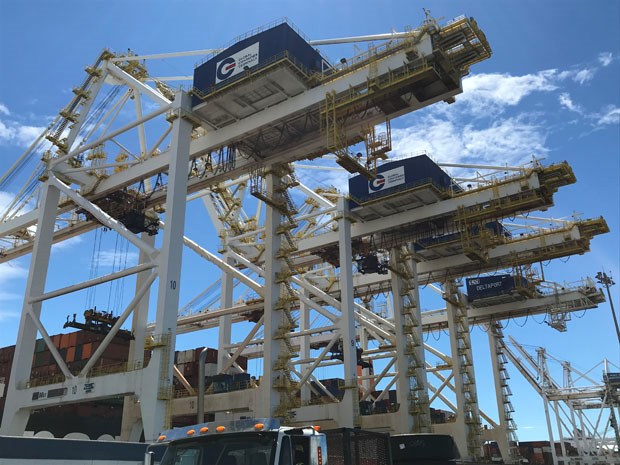The Port of Vancouver’s proposed Terminal 2 complex at Roberts Bank is outmoded and no longer viable, claims the current container terminal operator of Deltaport.
Global Containers Terminal latest submission last month to the Canadian Environmental Assessment Agency’s review panel for T2 paints a highly critical picture of the port authority’s reasoning for building a second three-berth container terminal in Delta, saying the project isn’t viable given changes in a number of market factors.
“It is GCT’s view that the long-term sustainability of our gateway is only achievable through careful terminal design that reflects a modern, innovative, and a more sustainable approach to planning and constructing such an expansion,” the submission by GCT states.
The company outlines several areas of concern regarding the project rationale, assessment and the port’s environmental impact statement.
GCT notes it’s important to consider that approximately 35 per cent of all inbound containers entering Canada’s West Coast ports are “discretionary” cargo, destined for the United States by rail. It means that importers and shipping lines can, at their discretion, redirect through other ports in Canada or U.S.
GCT says “there is material risk associated with discretionary cargo, and thus private capital is better suited than public funds to assume this risk in order to justify major terminal capacity projects.”
The company also notes further analysis is needed when it comes to T2 “to stress test impacts of changing world patterns, increasing protectionism, and shifts in manufacturing supply chains on the type and location of container capacity needed to support Canada’s trade. Such analysis would assist in avoiding building costly and potentially risky infrastructure projects with public funds.”
GCT hired a consultant to examine options including expansion at the existing Deltaport facility, finding that under a low trade growth scenario, neither T2 nor expansion of GCT Deltaport is required until after 2050. Under a medium trade growth scenario, only one of the two projects are required by 2050, while both would be required prior to 2050, but only under a high trade growth scenario.
“Additional market analysis is also required to determine the suitability of T2 as it relates to the changed marketplace for container shipping and the impacts that shipping alliance structures have on port capacity planning,” GCT states. Further information is required from the port on how they intend to remain sustainable if overcapacity is predicted through the 2030s, the terminal operator warns.
The submission goes on to raise several questions including the cumulative impacts resulting in the construction and operation of T2, as well as the enforceability of the proponent’s environmental mitigations.
The port authority had issued a request for bids from interested terminal operators to operator T2, which would be built on a man-made island adjacent to the existing Deltaport container terminal. The port wouldn’t allow GCT to submit a bid.
According to the Port of Vancouver, expanding the exiting Deltaport terminal is not an option for a couple of reasons, one being Fisheries and Oceans Canada having prohibited further land reclamation inland from Deltaport. Secondly, expanding Deltaport would mean one terminal operator, GCT, would control a significant majority of the market for container terminal services.
“Healthy competition is necessary to ensure users continue to pay reasonable rates to pay for reliable service,” the port states.
Saying the Port of Vancouver’s vision is to be the world’s most sustainable port, the authority’s Cliff Stewart and Tom Corsie made a presentation to Delta council March 4 to explain the rationale behind T2, noting their most recent assessment determined number of ships coming to the port will see little change but the amount of cargo, due to larger ships, will increase.
“Capacity shortfalls would likely create negative impacts on port users and local communities as a result of terminal congestion, including increased truck and train backups, vessel scheduling challenges, cargo redirection, increased truck traffic to and from the United States, increased transportation costs for Canadian goods, and the loss of business for importers and exporters,” the port’s most recent submission explains.



